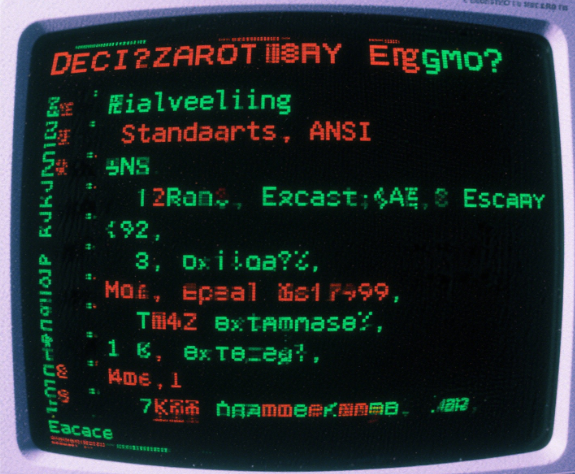In the intricate world of the terminal, where lines of text scroll by and commands come to life, there exists a hidden language that has the power to transform the user experience. ANSI escape codes, though often shrouded in mystery, play a crucial role in enhancing the usability and visual appeal of the terminal. For far too long, I, like many others, had only a hazy understanding of these codes – a vague notion that they were responsible for making text red or performing other visual tricks in the terminal. But as I delved deeper into the study of the terminal this year, I unearthed a fascinating world filled with standards, variations, and endless possibilities.
At their core, ANSI escape codes are the messengers that bridge the gap between the terminal emulator and the programs running within it. They carry information about colors, cursor movement, mouse actions, and much more. Picture this: you’re in the terminal, and with a simple keystroke, the cursor zips to a different position, or the text on the screen bursts into a vivid color. All of this magic is made possible by escape codes. There are two types: input codes, which the terminal emulator sends in response to keypresses or mouse movements that don’t fit neatly into the Unicode framework, and output codes, which programs can use to paint the terminal canvas with colors, move the cursor around, clear the screen, and even copy text to the clipboard.
The first standard that caught my attention was ECMA – 48, a document that dates back to 1976. This standard serves as a cornerstone, defining the general formats for escape codes, such as the widely – recognized CSI (Control Sequence Introducer) codes, which start with ESC[, and OSC (Operating System Command) codes, which begin with ESC]. It also lays out specific escape codes for basic functions, like moving the cursor left (ESC[D) or turning text red (ESC[31m). While ECMA – 48 provides a solid foundation, it’s far from comprehensive. Many of the features we take for granted in modern terminal applications, like mouse support, aren’t covered within its pages.
Enter xterm control sequences. When it comes to features not defined in ECMA – 48, such as enabling mouse reporting, bracketed paste, and the handy OSC 52 code for copying text to the system clipboard, xterm has been a major influencer. Although not a formal standard in the strictest sense, the list of what xterm supports has been widely adopted by other terminal emulators, making it an essential reference point in the world of escape codes.
In the 1980s, the terminal landscape was a wild west of varying escape code support. Different terminals could interpret the same code in completely different ways, or not at all. To bring some order to this chaos, the terminfo database was born. Managed by ncurses in many systems, terminfo, defined by the X/Open Curses standard, provides a comprehensive repository of escape codes for various terminals. It’s like a dictionary that programs can consult to figure out which codes to use based on the terminal type specified in the TERM environment variable.
However, the question of whether programs should rely on terminfo remains a topic of debate. Some applications, like fish, wholeheartedly embrace it, using the database to adapt to different terminal environments. Others, such as kakoune, python - prompt - toolkit, and several others, opt for a different approach. They identify a “single common set” of escape codes that they believe will work in a wide enough range of terminal emulators and hardcode those. A detailed rant from a fish maintainer even argues that terminfo, while once crucial, is no longer as relevant in today’s context.
The search for a definitive “single common set” of escape codes is like chasing a mirage. It seems to be a nebulous combination of codes supported by the VT100, those defined in ECMA – 48, and features from xterm. But even this combination isn’t foolproof, as not all of these codes are universally supported across all terminal emulators. And unlike the web, where resources like “Can I use…?” and “Baseline” help developers navigate browser compatibility, there’s no equivalent for the terminal world. While terminfo was meant to fill this role, its slow adoption of new features means it often falls short.
Still, terminfo has its defenders. In 2025, people on Mastodon pointed out valid reasons for its continued use. Some users rely on the TERM environment variable to control program behavior, and without terminfo, there’s no clear standard for how this should work. Additionally, despite the convergence of terminal emulators over the years, significant variations still exist, from graphical terminals to the Linux framebuffer console and more. And with no agreed – upon “single common set” of escape codes, terminfo provides a safety net for programs that need to support a wide range of terminal types.
The way ncurses uses the TERM environment variable to select escape codes is reminiscent of how web servers once relied on browser user agents. Just as browsers like Safari disguise their identities in user agent strings to work around poor detection, terminal emulators sometimes report themselves as something they’re not to ensure compatibility. On the web, we eventually moved away from relying on user agent detection in favor of standardization. Whether the terminal world will follow a similar path remains to be seen, especially given its more fragmented nature and limited resources.
As I explored further, I discovered a plethora of other documents and standards related to escape codes, from the Linux console_codes man page to the kitty keyboard protocol. Each of these adds another piece to the puzzle, contributing to the ever – evolving understanding of ANSI escape codes.
I find this whole topic incredibly fascinating, especially when I hear people dismiss the Unix terminal as “outdated.” I believe that by clarifying the standards landscape, we could unlock a new era of innovation for the terminal. Terminal emulator developers would have a clearer roadmap for building new features, and application authors could adopt those features with more confidence. It’s a lofty goal, and standardizing ANSI escape codes is no easy feat, as evidenced by the nearly 50 – year – long journey since the first publication of ECMA – 48. But if the web could transform from a chaotic mess of incompatible technologies to a relatively standardized ecosystem, there’s hope that the terminal world can follow suit, bringing a richer and more modern experience to all who venture into its command – line realm.




